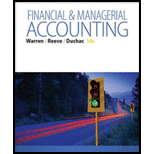
Issuing stock
Epstein Engineering Inc. began operations on January 5. 2016, with the issuance of 500,000 shares of $80 par common stock. The sole stockholders of Epstein Engineering Inc. are Barb Abrams and Dr. Amber Epstein, who organized Epstein Engineering Inc. with the objective of developing a new flu vaccine. Dr. Epstein claims that the flu vaccine, which is nearing the final development stage, will protect individuals against 90% of the flu types that have been medically identified. To complete the project, Epstein Engineering Inc. needs $25,000,000 of additional funds. The local banks have been unwilling to loan the funds because of the lack of sufficient collateral and the riskiness of the business.
The following is a conversation between Barb Abrams, the chief executive officer of Epstein Engineering Inc., and Amber Epstein, the leading researcher:
Barb: What are we going to do? The banks won't loan us any more money, and we've got to have $25 million to complete the project. We are so dose! It would be a disaster to quit now. The only thing I can think of is to issue additional stock Do you have any suggestions?
Amber: I guess you’re right. But if the banks won’t loan us any more money, how do you think we can find any investors to buy stock?
Barb: I’ve been thinking about that What if we promise the investors that we will pay them 5% of sales until they have received an amount equal to what they paid for the stock?
Amber: What happens when we pay back the $25 million? Do the investors get to keep the stock? If they do, it’ll dilute our ownership.
Barb: How about, if after we pay back the $25 million, we make them turn in their stock for $120 per share? That’s one and one-half times what they paid for it, plus they would have already gotten all their money back. That's a $120 profit per share for the investors.
Amber: It could work. We get our money, but don't have to pay any interest, dividends, or the $80 per share until we start generating sales. At the same time, the investors could get their money back plus $120 per share profit
Barb: We’ll need current financial statements for the new investors. I’ll get our accountant working on them and contact our attorney to draw up a legally binding contract for the new investors. Yes, this could work.
In late 2016, the attorney and the various regulatory authorities approved the new stock offering, and 312,500 shares of common stock were privately sold to new investors at the stock’s par of $80.
In preparing financial statements for 2016, Barb Abrams and Dan Fisher, the controller for Epstein Engineering Inc., have the following conversation:
Dan: Barb, I've got a problem.
Barb: What’s that Dan?
Dan: Issuing common stock to raise that additional $25 million was a great idea. But ...
Barb: But what?
Dan: I’ve got to prepare the 2016 annual financial statements, and I am not sure how to classify the common stock.
Barb: What do you mean? It’s common stock.
Dan: I’m not so sure. I called the auditor and explained how we are contractually obligated to pay the new stock-holders 5% of sales until $80 per share is paid. Then, we may be obligated to pay them $120 per share.
Barb: So…
Dan: So the auditor thinks that we should classify the additional issuance of $25 million as debt not stock And. if we put the $25 million on the
- 1. Discuss the arguments for and against classifying the issuance of the $25 million of stock as debt.
- 2. What do you think might be a practical solution to this classification problem?
Want to see the full answer?
Check out a sample textbook solution
Chapter 11 Solutions
Financial & Managerial Accounting
- General accountingarrow_forwardMaxwell Industries uses flexible budgets. At a normal capacity of 25,000 units, the budgeted manufacturing overhead is $75,000 variable and $300,000 fixed. If Maxwell Industries had actual overhead costs of $385,500 for 27,000 units produced, what is the difference between actual and budgeted costs?arrow_forwardTimberline Corporation, which manufactures wooden furniture, is developing direct labor standards. The basic direct labor rate is $23 per hour. Payroll taxes are 18% of the basic direct labor rate, while fringe benefits such as vacation and health care insurance are $9 per hour. What is the standard rate per direct labor hour?arrow_forward
- The Yen Company has fixed costs of $750,000 and variable costs are 70% of the selling price. To realize profits of $330,000 from sales of 620,000 units, the selling price per unit: ?arrow_forwardRehan Manufacturing's break-even point in units is 1,800. The sales price per unit is $20, and the variable cost per unit is $14. If the company sells 4,200 units, what will net income be?arrow_forwardnonearrow_forward
 Financial AccountingAccountingISBN:9781305088436Author:Carl Warren, Jim Reeve, Jonathan DuchacPublisher:Cengage Learning
Financial AccountingAccountingISBN:9781305088436Author:Carl Warren, Jim Reeve, Jonathan DuchacPublisher:Cengage Learning Financial AccountingAccountingISBN:9781337272124Author:Carl Warren, James M. Reeve, Jonathan DuchacPublisher:Cengage Learning
Financial AccountingAccountingISBN:9781337272124Author:Carl Warren, James M. Reeve, Jonathan DuchacPublisher:Cengage Learning Survey of Accounting (Accounting I)AccountingISBN:9781305961883Author:Carl WarrenPublisher:Cengage Learning
Survey of Accounting (Accounting I)AccountingISBN:9781305961883Author:Carl WarrenPublisher:Cengage Learning Financial & Managerial AccountingAccountingISBN:9781285866307Author:Carl Warren, James M. Reeve, Jonathan DuchacPublisher:Cengage Learning
Financial & Managerial AccountingAccountingISBN:9781285866307Author:Carl Warren, James M. Reeve, Jonathan DuchacPublisher:Cengage Learning




